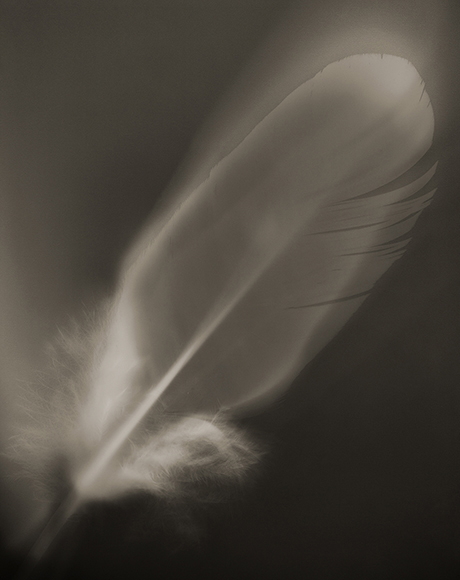 By Yumiko Izu
By Yumiko Izu
A little over a decade ago I left Manhattan to make my home in upstate New York. I now spend my days immersed in the wooded nature of the Hudson Highlands, where the comings and goings of birds are a great source of inspiration.
As the long harsh winter draws to a close and purple crocuses pop forth between lingering pockets of snow, songbirds that had vanished during the cold months begin to show themselves again. From morning to evening without a break I hear their mating calls. No sooner do these subside than the birds are setting about building nests all around my yard. Despite the thousands and tens of thousands of trees available to them in the deep woods, they seem to prefer nesting near human habitation, the better to protect themselves from predators. And so from day to day as I go about my own doings I find evidence of their lives in every conceivable place—under the eaves, on the porch, in the hydrangea bush outside my kitchen window, inside the canoe slung upside down in the garage.
And what an achievement a nest is—each one the result of countless trips to and fro, tiny beaks transporting twigs and straw and bits of moss. Examining these homes once the occupants have moved on, I see that each has its own shape and style; no two are ever alike. Sometimes I lose all sense of time, enrapt by the delicate beauty of their subtle curves and complex meshes. As with any intricately woven tale, each study brings new discoveries. Close inspection reveals the use of manmade materials—wisps of yarn and plastic, buttons, fragments of newspaper. Horsehair or dragonfly and moth wings might be worked into the structure, and inside may lie eggshells, feathers and, sometimes, bones or the lonely remains of an unhatched egg.
As I gaze upon the vacant nests and abandoned feathers, I feel poignantly the echoes of life and death they carry. Some of those hatchlings grew up hale and strong, gobbling up the sustenance brought to them by their parents. Others perished, waylaid by predators. Some eggs hatched while others did not; some fledglings alighted safely, others met their end. Slight and perilous indeed is the brink between life and death—so precipitous that one errant step can send one plunging down headlong, like Icarus in the Greek myth. Through these images I seek to capture that peril, and the record of life still evident in my subjects.
For its ability to capture traces of life, film is, I believe, the medium best suited to my concept for this series. Icarus is composed of two bodies of work: detailed platinum prints of birds’ nests taken on a large-format camera, and more abstract images rendered without a camera in the photogram method, using negative film.
Essay
Icarus
「イカロス 」
井津由美子
十数年前にマンハッタンを離れてニューヨーク北部のアップステイトに住み始めた。ハドソン川沿いの森の中での生活を通して、私は周りの自然からたくさんのインスピレーションを受けている。鳥の命の営みもそのうちのひとつだ。
厳しい冬がようやく終わりを告げ、残雪の間から紫のクロッカスが顔を覗かせる頃、冬の間には姿を見せなかった鳥たちが、どこからともなく姿を現わすのを目にする。 早朝から夕方まで休む間もなくさえずる鳥の求愛の歌を聴き続け、やっとそれが終わり一息つくと、今度はいっせいに私の家の周りで巣作りが始まる。森には何千何万という数の樹々が存在するにもかかわらず、鳥は外敵から身を守るためにあえて人間の近くに巣を作るようだ。 我が家の軒下やポーチ、キッチンの前の紫陽花の木やガレージに逆さに吊るされたカヌーの中。ありとあらゆる場所で自然の営みが繰り返されるのを、私は毎日眺めながら暮らしている。
尖ったくちばしに小枝や藁や苔をくわえ、数え切れないほど往復してようやく完成する鳥の巣。残された巣を見てみると、ひとつひとつが違う形や表情を持ち、同じものはひとつとして存在しない。複雑に編み込まれた模様や微妙な曲線、その繊細な造形美に時の経つのも忘れて見入ってしまうことがある。まるで精巧に編まれた物語を読んでいる時のように、見るたびに新たな発見がある。よく観察すると毛糸やビニールの端切れ、ボタンや新聞紙など人工的な素材も使われていることに気づく。馬の毛や蜻蛉や蛾の羽が編み込まれていたり、卵の殻や羽根が落ちていたり、骨や孵らなかった卵がポツリと残っていることもある。
空っぽの鳥の巣や残された羽根を見ていると、私の胸には、かつてそこに存在していた生と死の痕跡が色濃く迫ってくる。親鳥が与えるエサを無心に食べてたくましく成長するひな鳥たち。外敵に襲われて命を落とすひな鳥たち。孵る卵と孵らない卵、飛び立つひなと死んでいくひな。まるで一歩足を踏み外すと真っ逆さまに落ちてしまう空中のタイトロープのように、生と死の境界線はか細く危うい。私はその危うさを、対象に宿る命の記憶を写し取りたいと願った。
「ICARUS 」シリーズは、11×14インチの大型カメラで微細に表現された鳥の巣と、カメラを使わないフォトグラムという手法で写された羽根や巣や鳥のアブストラクトイメージの二部構成で成り立っている。